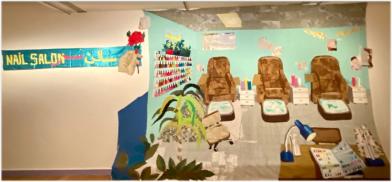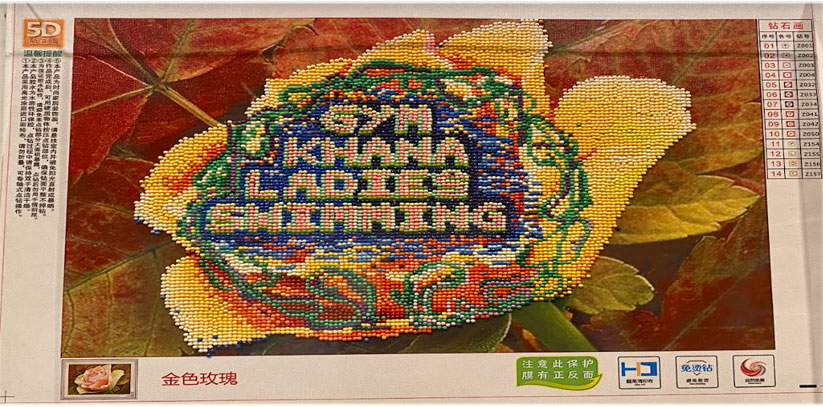Pop Art South Asia: A unique and irreverent creative collection of region's artists
It is impossible to take in the meticulously and painstakingly curated show, with more than 100 stimulating, multi-media works, spanning more than a century, in a single visit.

Despite the most obvious geographical, historical, social and cultural commonalities among South Asian countries, there is an almost complete silence around our shared identity, if not an active shying away from it. The Pop (Popular) Art Exhibition South Asia, at the Kiran Nadar Museum in New Delhi, shatters that reticence and offers brilliant, poignant expressions of the dreams and realities we share beyond borders.
At a time when our mainstream media is more focused on the divisions between and among South Asian countries, this exhibition does a stellar job of nudging our gaze, in the most quirky, irreverent and provocative way to our immediate surroundings.
Each artist on display is not only willing to look but to dwell and sharply comment on the politics and society as they see it. This is clear in the exhibit categories themselves – ‘Modernity & Urbanism’, ‘Politics, Protest, Borders, Partitions’, ‘Self Identity Diaspora’, ‘Utopia & Dystopia’, among others.
The middle-class aspiration for a ‘makaan’ (house) is lampooned in ‘Dominu Aeris – Middle Class Dreams 3’ by the contemporary, Delhi-based Thukral and Tagra where a residential skyscraper stretches unsustainably higher and higher into the sky like Jack’s beanstalk or a wizard’s pointy hat with cheerful symbols of middle-class life – drying clothes, a flag fluttering in the wind; the back of a cooler on the balcony.

Cinema's influence
The influence of commercial films with their role in normalizing violence and female objectification is also a major preoccupation. MF Husain’s photographs of garish film posters are followed by artists from India, Bangladesh and Pakistan, all satirizing the aggressive male as the glorified ‘hero’ and ‘fair’ heroines in satellite roles.
Mumbai-based Atul Dodiya’s ‘Gabbar on Gamboge’ is possibly the sharpest comment on this, showing two children reverently kneeling with heads bowed in front of Bollywood blockbuster Sholay’s famous villain Amjad Khan – certainly a sarcastic symbol of devotion, faith and violence that plagues the entire South Asian region without an exception!
Our ‘identity’ – the self-consciousness of how we see ourselves, and the defensiveness of how we want others to look at us is an enduring, albeit underlying, theme in many works.
Dhaka-based Samsul Alam Helal’s hilarious and sad series of ‘Love Studio’ is the most graphic in this exploration where the studio backdrops provide the aspirational and escapist spaces for hundreds of factory workers to fantasize about being in places that will remain inaccessible in real life.
It is impossible to take in the meticulously and painstakingly curated show, with more than 100 stimulating, multi-media works, spanning more than a century, in a single visit. And I have already visited it multiple times, and intend a few more. And each time it’s an exhilarating experience.
My two favourite works though, remain, Lahore-based Saba Khan’s ‘Gymkhana Ladies Swimming’ and US-based, Afghan Hangama Amir’s ‘Sahar, Nail Salon #1’. Both works are stark reminders of the unequal paradox of 'development' that sweeps across the region: pockets like India where women can move around (almost) freely and others where they are almost housebound, with various shades in between.
Khan's laboriously rendered cross-stitch work - manufactured like so many things that flood the South Asian market in China underlines the vagaries of patriarchal power in Pakistan where women have separate, isolated hours to swim, which can also be taken away on a whim.
Amir's large collage satirises how access to beauty treatment centres is owned and operated by men, and even this small space where women can meet and interact is not allowed to be controlled by women.
The works of all the artists are displayed in a loose thematic flow and there are almost no guessing nationalities; - even US-based Nepali Tsherin Sherpa's modern rendition of a Buddhist Tankhah - Luxation 2 - could be from Bhutan or Nepal, or Ladakh, Sikkim or Arunachal Pradesh in India. And this perhaps is the biggest triumph and testimony of our shared South Asian culture and identity - it can be ignored or denied, but it cannot be erased.
(The author is an educator, travel photographer and art lover. Views are personal. She can be reached at nirupamasekhri@gmail.com)










Post a Comment